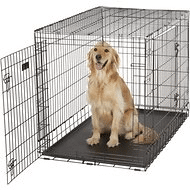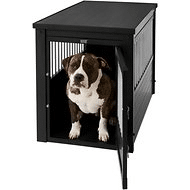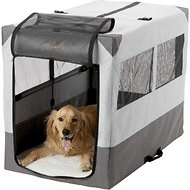6 Best Dog Crates for Boxers in 2024

Contents
- What is the Best Dog Crate for a Boxer?
- What is a Good Crate Size for Boxers?
- What to Look for in a Good Crate for Boxers
- Different Types of Dog Crates for Boxers
- Overall Best Dog Crates for Boxers
- 5 More Highly Rated Dog Crates for Boxers
- Tips for Crate Training Boxers
- Frequently Asked Questions
- Conclusion
Historically, the Boxers that many people think of today originated from Germany in the 1800s and were bred from the Bullenbeisser (“bull baiter”). Boxers were sleeker, quicker, and earned their name for the way they fought off opponents (by using their front paws like a prizefighter).
While Boxers have worked as police dogs, cattle herders, and even guide dogs, their favorite occupation is a family dog. Boxers are often happiest when they’re out on a walk or cuddling at their owner’s feet. If you already own a Boxer or are planning on adopting one, you’re going to need a crate.
Despite what some owners might tell you about crate training, organizations like the Humane Society argue that, when done correctly, it’s beneficial for both you and your Boxer. Your biggest challenge might not be deciding whether to buy a crate but finding the right one to buy.
The good news is you don’t need to do it alone—we’ve already compiled a list of the best Boxer crates currently on the market. Keep reading for a closer look at what we recommend, size recommendations, and answers to the frequently asked questions by Boxer owners.
What is the Best Dog Crate for a Boxer?
What is a Good Crate Size for Boxers?
While smaller female Boxers may only need a thirty-six-inch crate, most adult males require a forty-two-inch crate to lay down and lie comfortably. Keep in mind, however, that these are only the average recommendations. Before you buy anything for your pup, you should take your own measurements.
Once you’ve measured your dog’s height and width, you can take those numbers and add three or four inches. That will give you a rough estimate of what size you need. If the numbers add up to something odd (like thirty-three inches), it’s okay to purchase a thirty-six-inch crate. You can always give your Boxer a little more room to move around, but you shouldn’t buy something they’ll be cramped in.
What to Look for in a Good Crate for Boxers
If your Boxer is still a puppy that’s being house trained, you’ll want a crate that’s easy to clean. Cages that include removable cleaning trays make cleaning up after your pup more convenient while some soft kennels might be machine washable. Keep in mind that, in addition to dealing with whatever messes your Boxer leaves behind, you’ll also want to clean the crate regularly.
Being easy to clean isn’t the only feature to worry about: portability can also be a big deal. Even if you don’t plan on taking your Boxer on a lot of trips, you’ll still want to make sure you have a portable crate. You never know when you might need to take an unplanned trip to the vet or go out of town with your Boxer.
For a medium-sized breed like the Boxer, sizing can be tricky—and something you want to think about while you’re shopping. Since Boxers tend to grow quickly, one way to save money is by purchasing a kennel with divider panels. A divider panel will allow you to confine your Boxer to certain areas of the crate until they’re big enough to use the entire space.
Different Types of Dog Crates for Boxers
If you plan to keep the kennel confined to the indoors, a wooden crate may be the best choice. Unlike wire cages or plastic carriers, wooden crates give your Boxer plenty of security but don’t affect your dog’s airflow. They also tend to look more stylish than other types too.
However, some owners may shy away from wooden crates—especially if their Boxer is an aggressive chewer. Although they may be less stylish, wire cages are a lot more heavy-duty. For high-energy dogs like Boxers, wire cages tend to be the most durable option. Another positive is that they’re usually easy to clean too: if your Boxer has an accident, all you need to do is take out the removable tray and wash it off.
Overall Best Dog Crates for Boxers
| Our 2024 Picks: Boxer Dog Crates | |||
| Rank | Dog Crate | Price | Rating |
|
Best Overall |
 |
$$$ |
A+
|
|
#2 |
 |
$$$ |
A+
|
|
#3 |
 |
$$$$$ |
A
|
|
#4 |
 |
$ |
A-
|
|
#5 |
 |
$$$ |
B+
|
|
#6 |
 |
$$ |
B+
|
Your Boxer deserves the very best out there and we’ve taken the time to find out what the best Boxer crates are:
MidWest Ultima Pro Double Door Dog Crate
Best Overall
Boxers might not be the largest breed around, but these medium-sized dogs can cause a lot of trouble when they want to. To handle a heavy-duty dog, you’ll need a heavy-duty kennel like the MidWest Ultima Pro Double Door Dog Crate.
With tight mesh spacing that won’t allow your agile pup to slip between the bars, this crate uses durable metal that’s meant to last. For Boxer puppies that are still growing, you can use the divider panel to section off the areas you don’t need. If your pup happens to make a mess, it’s not a huge deal: the plastic pan is leak-proof and easy to wash out.
5 More Highly Rated Dog Crates for Boxers
Every dog has different needs, which is why we’ve added five more options that may suit your Boxer better:
Mr. Herzher’s Original Wicker Pet Residence
You’ve probably seen wicker in furniture, but it’s doubtful you’ve seen it in a dog crate like the Mr. Herzher’s Original Wicker Pet Residence. Here, this lightweight kennel uses rhino wicker on the side to provide your pup with somewhere comfier to lay. The spring-loaded door will also easily latch shut when you need it to.
One advantage to the rhino wicker is that it won’t absorb liquids or odors like some other materials might: if your Boxer happens to have an accident, it’s not the end of the world. The double tough pan is designed to catch messes as they happen.
ProSelect Empire Dog Cage
If your Boxer is an escape artist in disguise, you’ll need something secure like the ProSelect Empire Dog Cage to make sure they don’t pull a disappearing act. With half-inch thick tubing and sturdy steel that’s welded at stress points, this crate is designed for dogs that try to push or claw their way out of the crate. The slide latches are also positioned so that your Boxer can’t reach them with his paws.
If your Boxer has an accident, it’s okay: just slide the removable tray out and put it back in once it’s been rinsed off.
Petmate Compass Kennel
Although it wouldn’t fit an adult-sized Boxer, the Petmate Compass Kennel is a great choice for owners that are trying to haul Boxer puppies back from vet appointments and travel with them. Not only is the product easy to clean if your pup has an accident but it also uses a quick-latch design too.
That way, your Boxer won’t be able to escape from the crate when you aren’t looking. One advantage of this crate may have over similar choices is that it’s designed to meet most airline requirements. Instead of having to miss out on all the fun, this crate allows you to bring your Boxer along for the ride.
New Age Pet ecoFLEX Crate & End Table
Your Boxer may need an indoor crate, but many owners struggle to find one that doesn’t clash with their home’s interior. Fortunately, that isn’t a problem with the New Age Pet ecoFLEX Crate & End Table.
With stylish wood that blends seamlessly into your home’s decor, this wooden crate has another unique feature too. Since it uses eco-friendly wood and recycled plastic, purchasing this product also means supporting the environment.
When you need to clean the crate, the manufacturer recommends that you use a mild detergent so as not to irritate the wood.
MidWest Canine Camper Sportable Tent Dog Crate
When you’re out in the wilderness, there’s no reason you should have to leave your pup behind. With the MidWest Canine Camper Sportable Tent Dog Crate, you may not need to.
The sturdy steel frame makes setting it up effortless while the U-shaped wire adds even more stability. When you need to pack the crate back up, all you have to do is fold it down. The crate’s material is also designed to be water-resistant—and that includes rainwater or whatever messes your Boxer may leave inside.
Inside the crate, you’ll even find a sheepskin pad that adds a little bit of comfort and style to the tent.
Tips for Crate Training Boxers
You might already have the perfect crate picked out, but that doesn’t mean you’ll know what to do with it once you have it. If you’ve never crate-trained a Boxer before, here are a few tips that might come in handy:
- Never use the crate as a “time-out” or punishment for bad behavior. Crates may seem like an effective way to punish your Boxer after they act out, but it will only teach your dog to avoid the kennel in the future. The only case where it might be appropriate to lock your Boxer up after misbehaving is if your dog spills or breaks something and you need them out of the way while you clean up.
- Try putting the kennel somewhere in the house where you spend a lot of time. Your Boxer wants to be with you so they’re unlikely to spend a lot of time somewhere where you aren’t. It’s a good idea to put the kennel in the living room, kitchen or bedroom.
- Practice letting your Boxer stay in the crate for short periods before you leave them inside for extended amounts of time. It’s never a good idea to put your Boxer in the crate and leave them alone if you don’t know how they’ll handle it first. One way to check whether or not your Boxer is ready to be left alone is by locking him up for thirty minutes and leaving the room. If your pup constantly whines and paws at the door, chances are they aren’t ready to be home alone yet.
- Reward your Boxer for going inside the crate voluntarily with his favorite treats. Anytime your Boxer goes inside the crate without being forced to, you’ll want to give your pup a treat. Positive reinforcement like this will let your Boxer know that the kennel is a good place to be.
- If your Boxer won’t check the crate out himself, try using a few treats to lure him inside. Although dogs are naturally curious, sometimes your pup may need a little help. If your Boxer doesn’t try checking the crate out when you first bring it home, you may want to try using a few of his favorite treats to pique his interest. Sooner or later, your Boxer will realize there’s something yummy inside and go inside.
Frequently Asked Questions
When do I stop crate training?
There is no one-size-fits-all answer when it comes to crate training. While some owners may be able to stop crate training as soon as they can trust their Boxer not to tear apart the house, others have to crate train their dogs for up to three years. Ultimately, you’ll be the one to determine when crate training stops: if your Boxer can stay home alone without ripping up your favorite pair of shoes or knocking things over, then it might be time to stop crate training.
How long can my Boxer be in the crate?
While Boxer puppies shouldn’t be in the crate for longer than three or four hours (since they have limited control over their bowels), adult Boxers may be able to stay crated for longer. However, dogs who spend hours upon hours in a crate may begin to feel anxious or isolated. If you can avoid crating your pup for long periods, you should.
Is it cruel to crate train a pet?
Crate training is not cruel as long as it’s done correctly. In most cases, dogs end up loving their crates. Crate training only becomes cruel when owners use it as an excuse to keep their dogs locked up for several hours at a time frequently.
Why should I crate train my Boxer?
Crate training your Boxer can be beneficial for both you and your dog. Not only can it stop your pup from destroying your home or accidentally injuring himself while you’re away, but crates can be the perfect place for your Boxer to unwind after a long day.
Conclusion
Now that you know everything you need to, it might be time to at least begin thinking about buying your Boxer a crate. If you’re still feeling a little unsure about where to start, feel free to check out some of the best Boxer crates that we’ve reviewed for you above.



